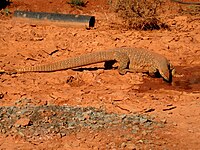Sand goanna
This article needs additional citations for verification. (April 2019) |
| Sand goanna | |
|---|---|

| |
| Gould's monitor or sand goanna in Mungo National Park, New South Wales, Australia | |
| Scientific classification | |
| Domain: | Eukaryota |
| Kingdom: | Animalia |
| Phylum: | Chordata |
| Class: | Reptilia |
| Order: | Squamata |
| Family: | Varanidae |
| Genus: | Varanus |
| Subgenus: | Varanus |
| Species: | V. gouldii
|
| Binomial name | |
| Varanus gouldii | |

| |
| Distribution of the sand goanna | |
| Synonyms[3] | |
| |
The sand goanna (Varanus gouldii), also known commonly as Gould's monitor, the racehorse goanna, and the sand monitor, is a species of large Australian monitor lizard in the family Varanidae.[4]
Taxonomy
John Edward Gray described the species in 1838 as Hydrosaurus gouldii,[3] noting the source of the type specimen as "New Holland" and distinguishing the new varanid by "two yellow streaks on the sides of the neck" and small flat scales at the orbits.[2] An earlier description, Tupinambis endrachtensis Péron, F. 1807, was determined as likely to refer to this animal, but the epithet gouldii was conserved and a new specimen designated as the type.[5][3] This neotype was obtained in 1997 at the near coastal Western Australian suburb of
The specific name, gouldii, is assumed to be a Latinised form of the surname of an associate of the describing author, the English ornithologist John Gould,[7] who was actively assembling specimens of fauna from Australia but is not thought to have any direct connection to this species.[5]
In some
Two subspecies are recognised,
- Varanus gouldii gouldii (Schlegel, 1837) – Gould's goanna
- Varanus gouldii flavirufus Mertens, 1958 – desert sand monitor
Description

A species of
Biology

Gould's monitor is a terrestrial reptile that excavates large
The sand monitor is a relentless
Like all goannas and snakes the sand monitor has a forked tongue, with which it "tastes" the air. Scents are picked up on each side of the fork which, when retracted, brushes over an area in the mouth called the Jacobson's organ, which identifies on which side the scent is stronger. Upon identifying this difference in scent strength the sand monitor can alter its direction accordingly. A 2021 study had shown that during the Miocene, Komodo dragons had hybridized with the ancestors of the sand goanna, thus providing evidence that the Komodo dragon had once inhabited Australia.[13][14][15]
Gallery
-
Sand goanna near Broken Hill
-
Sand monitor walking tracks in sand.
-
Bungarra at the Gidgee Gold Mine.
-
Bungarra at the Sunrise Dam Gold Mine.
-
Chace ranges, South Australia
-
Mungo National Park, NSW, Australia
-
Sand goanna at a camera lure
-
Sand goanna
Citations
- . Retrieved 19 November 2021.
- ^ .
- ^ a b c Australian Biological Resources Study (16 August 2012). "Subspecies Varanus gouldii gouldii (Gray, 1838)". Australian Faunal Directory. Canberra, Australian Capital Territory: Department of the Environment, Water, Heritage and the Arts, Australian Government. Retrieved 11 July 2019.
- ^ "Wild Herps - Sand Monitor (Varanus gouldii)". Wildherps.com. Retrieved 16 April 2018.
- ^ .
- ^ a b International Commission on Zoological Nomenclature (31 March 2000). "Opinion 1948". The Bulletin of Zoological Nomenclature. 57: 63–65.
- ISBN 978-1-4214-0135-5. (Varanus gouldii, p. 104).
- KarrathaVisitor Centre website, accessed: 30 July 2012
- ISBN 9780253343666.
- ^ "Varanus gouldii (Sand Monitor, Gould's Goanna)". Animal Diversity Web.
- ^ "Varanus gouldii ".
- ^ "Varanus gouldii ".
- PMID 33512509.
- ^ "Study reveals surprising history of world's largest lizard". phys.org. Retrieved 2021-03-06.
- ^ "Komodo dragons not only inhabited ancient Australia, but also mated with our sand monitors". Australian Geographic. 2021-03-03. Retrieved 2021-03-06.
General sources
- ISBN 1-875560-42-4. 226 pp.
- ISBN 0-589-07012-6.
- ISBN 0-86840-456-X.
- Thompson, G. G. (1995). "Foraging patterns and behaviours, body postures and movement speed for goannas, Varanus gouldii (Reptilia: Varanidae), in a semi-urban environment" (PDF). Journal of the Royal Society of Western Australia. 78 (4): 107–114.









